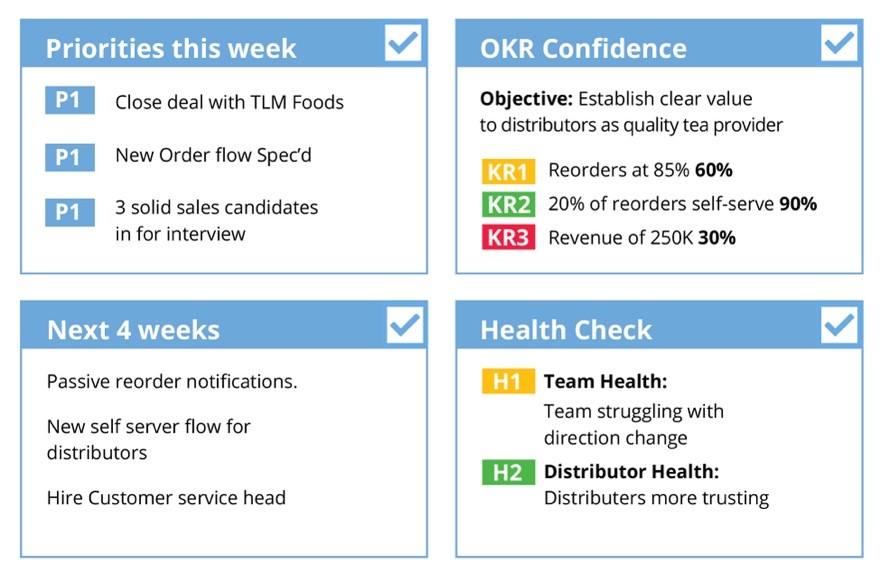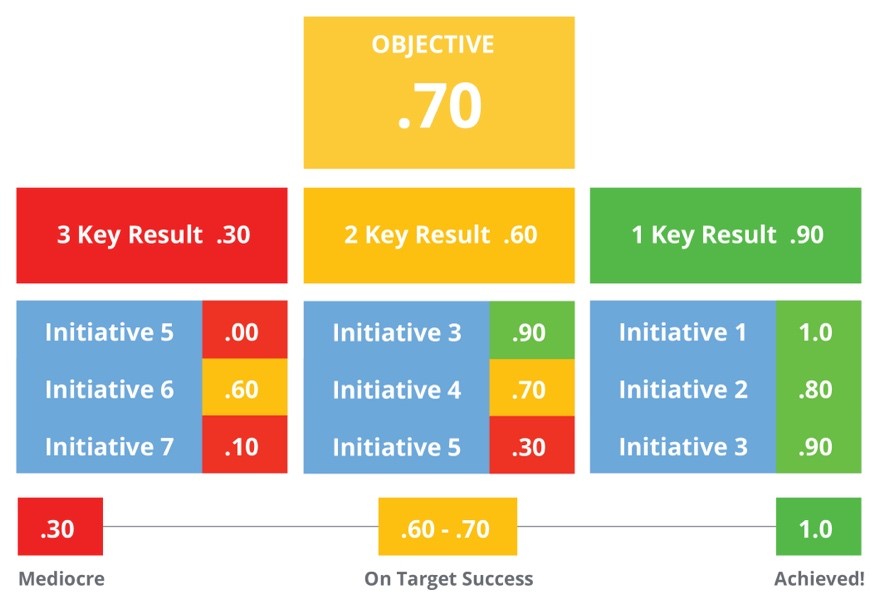
After going through the process of creating OKRs, it’s essential not to fall into the trap of “setting and forgetting.” Creating OKRs without regularly sharing and reviewing results is like hoping to win the lottery without buying a ticket. The modern business environment offers countless distractions, each vying for your attention. However, to execute successfully and elevate your performance, regular and disciplined reviews of OKR results must become part of your operating rhythm—a cadence embedded in your corporate culture.

Weekly Meetings
Let’s start with the basics: Weekly Meetings. The purpose of these sessions is threefold: assess progress, identify potential issues before they escalate, and, especially as you begin using OKRs, ensure your team stays focused on what truly matters. Here are some key topics to cover in your weekly meetings:
- Logistics: Begin by determining who should attend the meeting, what time works best for everyone, and where the meeting will be held.
- Priorities: What are the key priorities—the tasks that must be accomplished this week to move closer to achieving your OKRs? It’s easy to get caught up in the whirlwind of urgent issues, but it’s crucial to ensure the priorities discussed are directly tied to the achievement of your OKRs.
- Status: During the meeting, gauge the team’s current level of confidence. Has it increased or decreased? More importantly, why? If progress is on track, implement mechanisms to maintain momentum. If confidence is waning, it’s time to discuss how to shift resources strategically to get back on course.
- Engagement: OKRs should challenge and motivate people to engage in the breakthrough thinking necessary to reach new heights. Use the weekly session to assess the team’s mood. Are they still actively engaged, or are they simply going through the motions without genuine commitment?
- The Big Picture: Earlier, we defined a health metric as something the company monitors frequently because it represents successful strategy execution. Well-designed OKRs should ultimately drive the success of your overall health metrics, so ensure you’re keeping an eye on the bigger picture.

Weekly Quadrant Focus
One way of managing your OKRs effectively is to break down your weekly focus using a quadrant approach. This method ensures that your team stays aligned with the goals that matter most, while also keeping an eye on the broader picture.
Upper Right | Setting Bold Objectives and Quantitative Results
At the start of each quarter, we set a bold, qualitative Objective along with three quantitative Key Results. The Objective serves as the inspiration for the quarter, guiding our efforts and providing a clear direction. The Key Results are the measurable outcomes we expect if we focus on the right activities.
Each week, we revisit these Key Results and ask ourselves: Are we getting closer to achieving them, or are we falling behind? At the beginning of the quarter, we start with a 50% confidence level—a 50/50 (0.5) chance of hitting the target. As the weeks progress, this confidence level may fluctuate. If it drops from, say, 80% (0.8) to 20% (0.2), it’s a signal that something has changed. The critical question then becomes: What happened, and how can we address and improve this Key Result?
Lower Right | Monitoring Health Metrics
While we aim high with our Objectives, we can’t afford to ignore the fundamentals—our “health metrics.” This lower-right quadrant is where we track these vital signs of our business, ensuring that while we reach for ambitious goals, we don’t lose sight of what’s already working well.
For example, if our Objective is radical revenue growth, it’s easy to get caught up in the pursuit of new clients. However, we must also protect our relationships with current clients. In this quadrant, we might monitor Customer Satisfaction, rating it green, yellow, or red. This helps us ensure that our drive for growth doesn’t come at the expense of the clients who have already invested in us.
Upper Left | Weekly Initiatives to Advance OKRs
In the upper-left quadrant, we focus on the specific initiatives we need to tackle this week to advance our OKRs. These are the three to five critical actions that will move the needle.
We don’t list every task here—just the ones that must happen for us to achieve our Objectives. Life always throws plenty of distractions our way, but the secret to success lies in focusing on what truly matters. By sharing these initiatives, we can challenge ourselves to ensure we’re investing our time in activities that directly contribute to our Key Results.
Lower Left | Heads Up for the Month Ahead
Finally, the lower-left quadrant is our “heads up” space—a pipeline of important activities expected in the coming month. This area is crucial for keeping the entire team, including Marketing, Sales, Operations, and Admin, prepared and aligned.
By anticipating what’s coming down the road, we avoid being caught off guard. This forward-looking approach ensures that everyone is ready to support key initiatives when the time comes.

End of Quarter Reviews
At the end of each quarter, it’s time to move beyond subjective assessments and grade your performance. The two primary components of the quarterly review meeting are the “what” and the “how.”
- The “What”: This involves assigning grades (scores) to each of your key results based on performance throughout the quarter. Each team (or individual, if your OKRs are connected that far into the organization) will determine their final score and provide the rationale to peers, colleagues, and superiors. This transparency offers a valuable opportunity for teams to learn from each other’s objectives, key results, triumphs, and challenges—showing what’s possible when the entire organization is aligned.
- The “How”: While the grades are important, the real value lies in the discussions that follow. These conversations should challenge conventional views, uncover assumptions, and test hypotheses. In our experience, many organizations struggle with these meetings, where honesty and candor should take center stage. Some companies are able to engage in passionate, no-holds-barred discussions, while others are hampered by an overly polite culture that stifles genuine debate. Recent research into effective teams highlights the importance of psychological safety as a critical enabler of group success. To make the most of your OKR data, you need to carefully structure your meetings to maximize learning and drive meaningful change.
Updating OKRs at the End of a Quarter
The mechanics of OKR creation are straightforward. At the beginning of each year, the company establishes its highest-level set of OKRs, which may include both strategic annual OKRs and more tactical quarterly OKRs. These “corporate” OKRs provide the context for the connecting process, where business units, teams, and possibly even individuals create their own OKRs to demonstrate their contribution to the overall strategy.
At the end of each quarter, OKRs are graded, and new OKRs are developed throughout the organization. Some OKRs may remain the same for several quarters, especially those that are critical given current strategic or operational challenges. You may also carry forward OKRs that weren’t fully achieved but remain strategically important. Any OKRs that were successfully completed will likely be replaced with new ones that once again stretch the team to deliver their best.
Scoring the Results
Here’s a quick guide to interpreting OKR scores:
- 1.0 Score: This represents an extremely ambitious outcome—one that may have seemed nearly impossible at the outset. All key results should be written as a 1.0 to foster breakthrough thinking. It might feel like a “moonshot” if the company has never approached that level of performance before.
- 0.6 – 0.7 Score: This level signifies difficult but attainable progress, and it’s what you hope to achieve at a minimum. It’s a lofty target—challenging but achievable based on past results.
- 0.3 Score: This is the “business as usual” target, representing performance that can be achieved with standard effort and little or no assistance from other teams. It’s considered mediocre—precisely what OKRs are designed to eliminate. If a team only reaches a 0.3 on a key result, it’s crucial to understand why.

In our experience, those new to OKRs often encounter one of two outcomes: either they score all ones, or they find themselves scratching their heads because despite their best efforts, their reports are filled with zeros.
After a few quarters, your key result scores should average around 0.6 to 0.7. If your scores are consistently higher, it may indicate that your targets aren’t aggressive enough, and you’re not fully leveraging the talent and potential of your teams.
By following these practices, you can ensure that your OKRs aren’t just another set of goals but a powerful tool for driving strategic execution and achieving your company’s most ambitious objectives.
And with that, we conclude our five-part series on OKRs. We hope these insights help you harness the full potential of OKRs in your organization. Here’s to your success!
CONTACT INFO NEEDED

Bill Gelbaugh is one of our Senior Partners here at Outhouse and champions our OKR efforts.
Summarized by Bill Gelbaugh from: Objectives and Key Results by Paul R. Niven and Ben Lamorte
With additional material from Measure What Matters, Lattice OKR 101 and Perdoo